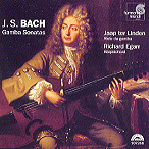Jordi Savall and Ton Koopman recorded these sonatas years ago, a disc that is happily still in the catalog (Virgin Veritas). Only their recent retake on Alia Vox, which is freer and features superior recorded sound, can beat it. Now, stellar continuo player Jaap ter Linden brings his excellent technique and vast Baroque performance experience to the table. Although he presents his ideas with clarity and precision, and his playing is very smooth and even-toned, it’s all just a bit too fastidious. The rise and fall of Bach’s phrases are small bumps rather than the well-defined hills and valleys that are in the score, and much of the performance has a detached feeling. From the opening notes of the G major Sonata it is obvious whose version has more life to it: Savall’s playing is more vibrant, his tone much more lush. In the second movement of the D major Sonata, Linden dances lightly through the phrases while Savall heaves and sighs, bringing out the poignancy when the music shifts to the minor key. The punctuation of the G minor Sonata’s main motif (first movement) fairly leaps off the page when Savall plays it, and his forward motion feels more natural than Linden’s. As a Baroque cellist, Linden has given an excellent account of Bach’s solo cello suites, making all kinds of wonderful things happen in the myriad dance moods there, so it’s a bit disappointing that he doesn’t really sparkle here.
Richard Egarr’s accompaniment is first rate, with finely shaped lines and well-placed cadences. His abilities are even better displayed in the added bonus tracks–two solo keyboard Capriccios–but his contribution is not enough to carry this release over the top. Both of Savall’s versions feature a richer viola da gamba tone and more vibrant harpsichord playing than the competition, namely Wieland Kuijken and Gustav Leonhardt (DHM), as well as Juan Quintana/Céline Frisch and Paolo Pandolfo/Rinaldo Alessandrini (both on Harmonia Mundi—see reviews.) Although Harmonia Mundi’s recorded sound is quite good (details are invariably clearer than the other versions mentioned), either of the Savall interpretations is preferable.
































